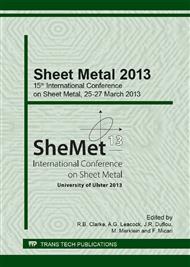[1]
T. I. Matuszyk: shape characterization of sheet metal assembly variation with a view to quality assessment and dimensional control, Dissertation, Australian National University, 2008
[2]
T. Schenk: Modeling of welding distortion, the influence of clamping and sequencing, Dissertation, TU Delft, Netherlands, 2011
[3]
A. Eckert: Prognose der Maßhaltigkeit punktförmig mechanisch gefügter Karosserieanbauteile, Dissertation, Technische Universität Chemnitz, 2012
[4]
D. Tikhomirov, B. Rietman, K. Kose, M. Makkink: Computing Welding Distortion: Comparison of different industrially applicable methods, Advanced Materials Research Vols. 6-8, (2005) 195-202,
[5]
O. Hahn, J.R. Kurzok, A. Rohde, T. Thesing: Rechnergestützte Dimensionierung widerstandspunktgeschweißter und mechanisch gefügter Bauteile, Schweißen und Schneiden 51 (1), (1999), 17-23
[6]
Y. Ueda, K. Fukuda, and M. Tanigawa: New measuring method of three dimensional residual stresses based on theory of inherent strain, Transactions of JWRI 8(2), (1979), 249-256
[7]
Y. Ueda, M.G. Yuan: Prediction of residual stresses in butt welded plates using inherent strains. Transactions of the ASME, Journal of Engineering Materials and Technology 115(10), (1993), 417 to 423.
[8]
Y. Luo, H. Murakawa, Y. Ueda: Prediction of welding deformation and residual stress by elastic FEM based on inherent strain, (Report I) – Mechanism of inherent strain production, Transactions of JWRI 26(2), (1997), 49–57
[9]
H. Murakawa, D. Deng, N. Ma, J. Wang: Applications of inherent strain and interface element to simulation of welding deformation in thin plate structures, Computational Materials Science 51, Elsevier B.V. (2011), 43–52
[10]
S. R. Daniewicz, M. D. McAninch, B. Mc-Farland, D. Knoll: Application of distortion control technology during fabrication of large offshore structures, AWS/ONRL International Conference on Modeling and Control of Joining Processes, Orlando, Fla., 1993
[11]
A. Bachorski, M. J. Painter, A. J. Smailes, M.A. Wahab: Finite-element prediction of distortion during gas metal arc welding using the shrinkage volume approach, Journal of Materials Processing Technology 92-93 (1999) 405-409.
[12]
C. Stapelfeld, A. Kloshek, N. Doynov, V. G. Michailov: Analytisches Schrumpfkraftmodell und Berechnungsprogramm zur Bestimmung des schweißbedingten Verzugs, DVS-Berichte, Band 250, DVS Verlag Düsseldorf, (2008), 401-405
[13]
D. Tikhomirov, B. Rietman, C. Schwenk, T. Franz: Methoden der Schweißverzugssimulation für die Anwendung in der Automobilindustrie. Schweißen und Schneiden, 59 (12), (2007), 678-680.
[14]
P. Michaleris, A. DeBiccari: Prediction of Welding Distortion, Welding Journal, vol. 76(4), (1997), 172-180
[15]
L.F. Andersen: Residual Stresses and deformations in steel Structures, PhD Dissertation, University of Denmark, 2000
[16]
S. Christoph, D. Nikolay, M. Vesselin: Hybride Berechnungsansätze zur Prognostizierung und Minimierung des Verzugs komplexer Schweißkonstruktionen. Lehrstuhl Fügetechnik, Technische Universität Cottbus, Tagungsband SYSWELD Forum 2009
[17]
W. Perret, R. Thater, U. Alber, C. Schwenk, M. Rethmeier: Case Study for Welding Simulation in the Automotive Industry, Welding in the World 55, No. 11/12, (2011), 89-98
[18]
C. Hackmair, E. Werner, M. Pönisch. Application of welding simulation for chassis components within the development of manufacturing methods, Computational Materials Science, Vol. 28, (2003), 540-547
[19]
C. Wentao: In-plane shrinkage strains and their effects on welding distortion in thin-wall structures Dissertation, Ohio State University, 2005
[20]
L. Papadakis: A computer aided chaining approach for predicting the shape accuracy in manufacture of automotive structures, Production Engineering, Vol. 4, Issue 4, (2010), 349-355
[21]
U. Alber, R. Thater: Anwendung der Schweißsimulation an einem Beispiel aus der Automobilindustrie, Workshop "Anwendungsnahe Schweißsimulation" 19.05.11 Berlin, 2011
[22]
B. Lenz: Finite Elemente-Modellierung des Laserstrahlschweißens für den Einsatz in der Fertigungsplanung. Dissertation, Technische Universität München, 2001
[23]
X. Fan, L. Masters, R. Roy, D. Williams: Simulation of distortion induced in assemblies by spot welding, Engineering Manufacture, Vol. 221, 2007
[24]
R. Neugebauer, M. Roessinger, M. Wahl, F. Schulz, A. Eckert, W. Schuetzle: Predicting Dimensional Accuracy of Mechanically Joined Car Body Assemblies, SheMet Conference 2011, Leuven, Belgium.
Google Scholar


